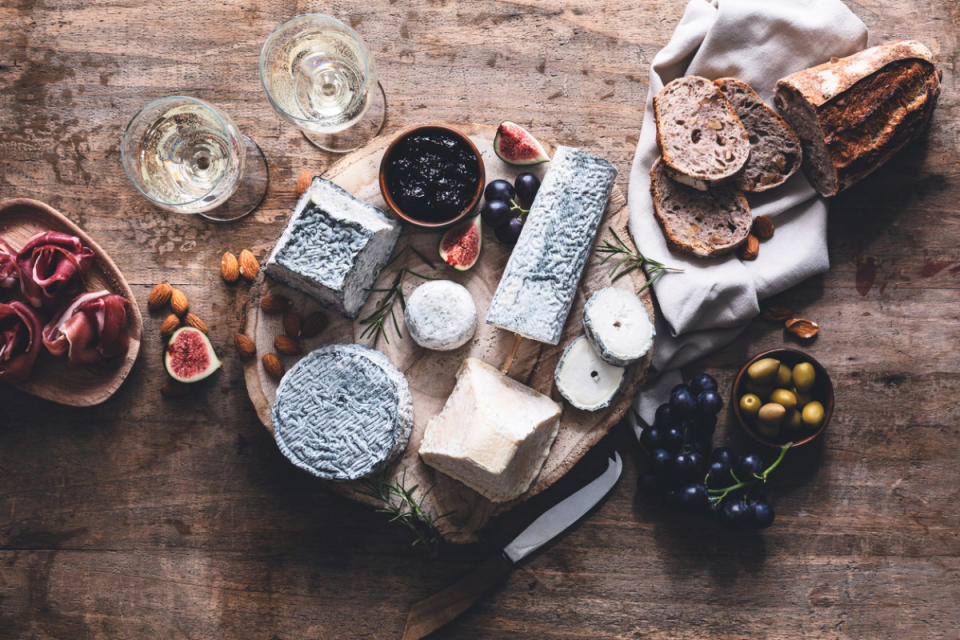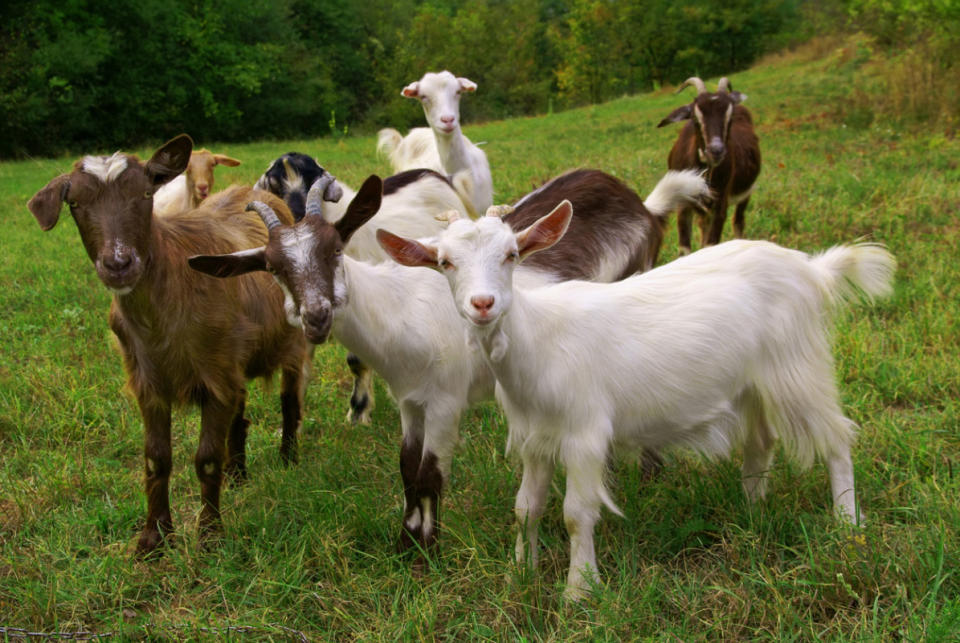8 Whey Cool Things to Know about Goat Cheese, According to Cheese Experts

Wanna learn some whey cool facts about one of our favorite cheeses? (Sorry, we couldn't help it!) Goat cheese, or its French name, chèvre (meaning goat), has grown in popularity over the years, going from something you'd find on a restaurant menu (maybe on a beet salad) to a cheese that you pick up when you're building your charcuterie boards.
The tangy, creamy cheese is not only a crowd-pleaser, but it also has some pretty cool health benefits as well—and the tangy, cheesy category goes way beyond that log of fresh goat cheese you see at the supermarket. To help you get up to speed on all things goat cheese we quizzed the experts. Read on to learn more about this GOAT of the cheese world.
Related: 10 Crazy Good Goat Cheese Recipes

iStock
1. What Does Goat Cheese Taste Like?
Megan Wiggers, a Certified Cheese Professional and Specialty Team Leader at Whole Foods Market White Plains, NY says that, in general, goat cheese has a distinct tang, especially in a fresh chevre or a soft-ripened cheese, like goat’s milk Brie.
"It can also taste very earthy," she says, "and I find some goat cheeses to have bright citrus notes like lemon and grapefruit. Flavor notes of the cheeses are based on many factors, including the climate where the goats live, what the animals eat, how the cheese is aged and produced, and more."
2. What's the Best Temperature for Serving Goat Cheese?
Wiggers says the more you eat goat cheese, the easier it will be to identify the unique notes of each cheese (so consider this your permission to indulge). To get the fullest flavor of the cheese, she also recommends bringing the cheese to room temperature before eating it. "This allows the cheese to sing its notes instead of whispering them and is well worth the wait," she says.
Related: 31 Types of Cheese To Add to Your Next Charcuterie Board
3. What's the Difference Between Fresh and Aged Goat Cheese?
When we think of goat cheese, we usually think of fresh goat cheese (aka the log from the store). "Fresh cheese is not aged at all and does not have a rind—a good example of this is a goat cheese log," says Wiggers. "These can be plain, which really highlights the quality of milk, or they can be rolled in garlic, herbs or other seasonings, bringing extra flavor to the cheese."Aged goat cheese, on the other hand, says Wiggers, is a bit different. "Aged cheeses have a sturdy rind which will be natural, waxed or clothbound. They can be hard, semi-firm or soft-ripened." There are a lot of different varieties you might find at the grocery store, too.
4. What Are the Different Types of Goat Cheeses at the Store?
Kim Dunn, Certified Cheese Professional and Senior Category Merchant for Whole Foods Market says that there are many different kinds of aged and fresh goat cheeses to try.
"Goat cheeses come from many different origins with variety of ages and styles, therefore you will find that there is a wide range of flavors, textures and aromas," she says. "Just like other cheeses of different milk types, the cheese could be simple and fresh, marinated, rolled in herbs, or aged and bathed in wine, like Drunken Goat cheese from Spain. You may experience soft and spreadable with a tangy citrus note to firm and crystally with a nutty and brown buttery flavor."
Some of Dunn and Wigger's favorites from both the aged and fresh categories include the following:
Gouda: A goat's milk gouda such as Midnight Moon Gouda (made in Holland) is a terrific semi-firm goat’s milk gouda with nutty, floral and sweet notes.
Soft-ripened cheeses: These include Sofia from Capriole Goat Cheese, which is a French-inspired ash-ripened, bright, tangy cheese, and Chabichou, a French cheese in a cylinder shape with a firm and creamy texture and a zesty, grassy flavor. Another favorite is Vermont Creamery Bonne Bouche – (“Bonnne Bouche” means "good mouthfeel" in French). This cheese is soft and ash-ripened from Vermont with bold, earthy, bready flavors balanced with mellow tanginess.
Hard-aged cheese: One in particular is Garrotxa (from Spain), which has a walnutty flavor. This cheese is bright on the front end with grassy and herbal notes on the tail end.
Spreadable goat cheese: This category includes cheeses like Laura Chenel Marinated Goat Cheeses. They're creamy, soft, spreadable, savory and vibrant.
Brie: One great example is Whole Foods Market Double Cream Goat Brie, an approachable, creamy French cheese with a subtle pleasant tang.
Blue: Blue cheese made from goat's milk is often quite punchy, much like other blue cheeses. One to try: Mitica Andazul, which has a funky fudgy flavor.
Related: I Went to Whole Foods With My Chef-Husband and My Grocery Shopping is Forever Changed

iStock
5. What's the Difference Between Raw and Pasteurized Goat Cheese?
There are benefits to raw and pasteurized cheese, according to Wiggers, and both can be super flavorful.
"While the pasteurization process is helpful in eliminating bad bacteria, it can also kill the good bacteria that contribute to the flavor, texture and overall composition of the cheese, and that may be unique to the cheese’s terroir (the environmental elements of where the cheese was made)," she says.
It’s important to note that raw milk soft-ripened cheeses in the U.S. cannot be aged less than 60 days due to FDA guidelines, which limits the number of raw cheeses available in the U.S.
Wiggers says that some people believe that raw cheeses are more flavorful, but, as in all aspects of cheese enjoying, "it comes down to quality of the cheesemaker and your own personal taste buds," noting that there are some very lovely pasteurized goat cheeses in the U.S. that are full of flavor, such as Vermont Creamery’s Bonne Bouche, Coupole or Bijou (this writer's personal fave).
"I love to pair Bijou with Dalmatia Organic Sour Cherry Spread, prosciutto and Nassau Candy Milk Chocolate Peanut Butter Cups," Wiggers says.
Dr. Caley Scott, ND, a practitioner at WholeHealth Chicago, says that there are some health benefits associated with raw cheese (when you can find it). "Raw cheese is higher in vitamins and omega-3 fatty acids than cheeses that are more processed," she says.
Related: Here’s What Happens to Your Body if You Eat Cheese Every Day

iStock
6. What About the Difference Between French and American Goat Cheese?
According to Wiggers, a large difference between French and American goat cheese is that American cheesemakers, as mentioned above, must follow FDA guidelines.
"Many French cheesemakers are also rooted in their traditions and PDO (Protected Designation of Origin) status of cheeses," she says. "A good example comes from Valencay—their raw milk, ash-ripened goat’s milk cheese is in the shape of a pyramid. If you want a similar cheese made in the U.S., Sofia from Capriole Goat Cheese is a pasteurized ash-ripened cheese. It is one of my current favorites and is happily represented in my cheese case right now!"
7. Is Feta a Goat Cheese?
Wiggers says feta can be made from all types of milk, though the feta you're using to make baked feta pasta or crumbling into your salads is most likely made with cow's milk.
"In traditional Greek recipes, feta is made with sheep and goat’s milk, like the Mt. Vikos brand we carry, [however], the 365 by Whole Foods Market Feta is made with cow’s milk," she says. "We also carry a lovely French feta from Valbreso made solely from sheep’s milk. My favorite feta is the Meredith Dairy Farmstead Sheep & Goat Cheese—it's marinated in Australian Extra Virgin Olive Oil, garlic and herbs. I love adding it to avocado toast."
8. Can You Use Goat Cheese and Cow's Milk Cheese Interchangeably in Recipes?
It depends, Wiggers says. Your recipe may require a tart goat cheese vs. a cow’s milk cheese and both can be very different.
"For example, a crumbled goat cheese might elevate and complement your summer salad of earthy beets more than a shredded cheddar would," she says. "That said, I believe 'better' is subjective as all cheeses can be enjoyed in different ways and recipes. If you made the same recipe twice—one with goat cheese, the other with cow—while they’d taste very different, they would likely be equally delicious in their own rights."
Wiggers says as long as you follow the golden rule (let that cheese come to room temperature please!), you can use most of them in the same ways: beautifully displayed on a cheese board with accouterments, combined with other ingredients in a delicious recipe or enjoyed directly straight from the package (we won't tell).
So, permission granted: get to cheesin' and thank us later.

 Yahoo Lifestyle
Yahoo Lifestyle 
